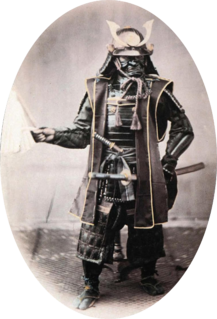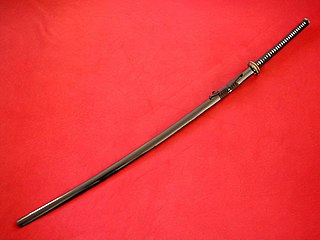Related Research Articles

Samurai were the hereditary military nobility and officer caste of medieval and early-modern Japan from the late 12th century to their abolition in 1876. They were the well-paid retainers of the daimyo. They had high prestige and special privileges such as wearing two swords. They cultivated the bushido codes of martial virtues, indifference to pain, and unflinching loyalty, engaging in many local battles. Though they had predecessors in earlier military and administrative officers, the samurai truly emerged during the Kamakura shogunate, ruling from c.1185–1333. They became the ruling political class, with significant power but also significant responsibility. During the 13th century, the samurai proved themselves as adept warriors against the invading Mongols. During the peaceful Edo era, they became the stewards and chamberlains of the daimyo estates, gaining managerial experience and education. In the 1870s samurai families comprised 5% of the population. As modern militaries emerged in the 19th century, the Samurai were rendered increasingly obsolete as very expensive to maintain compared to the average conscript soldier. The Meiji Restoration ended their feudal roles, and they moved into professional and entrepreneurial roles. Their memory and weaponry remain prominent in Japanese popular culture.

A tantō is one of the traditionally made Japanese swords that were worn by the samurai class of feudal Japan. The tantō dates to the Heian period, when it was mainly used as a weapon but evolved in design over the years to become more ornate. Tantō were used in traditional martial arts (tantojutsu). The term has seen a resurgence in the West since the 1980s as a point style of modern tactical knives, designed for piercing or stabbing.

Shurikenjutsu (手裏剣術) is a general term describing the traditional Japanese martial arts of throwing shuriken, which are small, hand-held weapons used primarily by the Samurai in feudal Japan, such as metal spikes bō shuriken, circular plates of metal known as hira shuriken, and knives (tantō).

The ōdachi (大太刀) or nodachi is a type of traditionally made Japanese sword used by the samurai class of feudal Japan. The Chinese equivalent of this type of sword in terms of weight and length is the miaodao, and the Western battlefield equivalent is the Zweihänder or claymore.

Saitō Musashibō Benkei, popularly known as simply Benkei, was a Japanese warrior monk (sōhei) who lived in the latter years of the Heian Period (794–1185)[1]. Benkei led a varied life, first becoming a monk, then a mountain ascetic, and then a rogue warrior. He later came to respect and serve the famous warrior Minamoto no Yoshitsune, also known as Ushiwakamaru. He is commonly depicted as a man of great strength and loyalty, and a popular subject of Japanese folklore, showcased in many ancient and modern literature and productions.
Kiri-sute gomen is an old Japanese expression dating back to the feudal era right to strike. Samurai had the right to strike with sword at anyone of a lower class who compromised their honour.

Carried by the Wind: Tsukikage Ran is an animated action comedy written and directed by Akitaro Daichi, and produced by Madhouse Studios. The television series follows Ran and Meow, two wanderers who face all sorts of antagonists in Tokugawa Japan.
Shigeru Muroi is a Japanese actress. She won the award for Best Supporting Actress at the 19th Hochi Film Awards for Izakaya Yūrei.

Samurai Rebellion is a 1967 Japanese jidaigeki film directed by Masaki Kobayashi. The film is based on Hairyozuma shimatsu, a short story by Yasuhiko Takiguchi.
A kiseru (煙管) is a Japanese smoking pipe, traditionally used for smoking kizami, a finely shredded tobacco product resembling hair.

An uchigatana is a type of Japanese sword worn by the samurai class of feudal Japan. The uchigatana was the descendant of the tachi.

Kumihimo is a traditional Japanese artform of making braids and cords. Literally meaning "gathered threads", kumihimo are made by interlacing reels of yarn, commonly silk, with the use of traditional, specialised looms - either a marudai or a takadai (高台).

Kate-bukuro a commonly used component within samurai attire during periods such as the Sengoku period of Japan. A Kate-bukuro was a provisional bag used by the samurai class and their retainers. For ordinary officers however, these provisional bags had been called by the name, Koshi-zuto. These types of bags were made of twisted paper strings within the style of fine basketwork, and measures around 1 shaku to 9 sun. These bags will then be carried within the right side of the waist. Another bag is also advised to be carried, which is 3 or 4 go of rice that is raw. Baked rice is also regularly employed when amongst cold weather due to the emission of heat.

Kubi bukuro (首袋) is a type of string bag used by the samurai class primarily during the Sengoku period of Japan. Kubi bukuro literally means 'head bag'. This type of bag was made out of net to carry a severed enemy head. When walking, it is hung it from the waist. When the owner is riding a horse, the bag is fastened to the saddle. Samurai commanders carried many of these Kubi bukuro.

Kabura-ya is a type of Japanese arrow used by the samurai class of feudal Japan. Kabura-ya were arrows which whistled when shot and were used in ritual archery exchanges before formal medieval battles.
Shoami is a name of artistic school (style) for making sword-guards (tsuba), mounted on a Japanese sword. The sword-guard is one of the most important symbols of the samurai.

A shūgi-bukuro is a special envelope in which money is given as a gift of celebration in Japan, especially at weddings or other auspicious occasions, such as a birth or celebrating a new home. The giver inserts the money into a shūgi-bukuro on which they have written their name, and the amount of money inside. In the case of weddings, the shūgi-bukuro is handed to the receptionist of the reception party; otherwise, the money is collected by the person themselves, with the envelopes acting as a record of who gave money and how much they gave. Shūgi-bukuro are sold at supermarkets and stationery stores.

Sukiya-zukuri (数寄屋造り) is one type of Japanese residential architectural style. Suki means refined, well cultivated taste and delight in elegant pursuits and refers to enjoyment of the exquisitely performed tea ceremony.

A money bag is a bag normally used to hold and transport coins and banknotes, often closed with a drawstring. When transported between banks and other institutions, money bags are usually moved in an armored car or a money train. It is a type of currency packaging. The money bag has had great success in cartoons and other light popular culture.

Kura (鞍), is the generic name for the Japanese saddle. The word "kura" is most commonly associated with the saddle used by the samurai class of feudal Japan. Over time the Japanese added elements of their own until the Japanese saddle became an identifiable style, also known as the samurai saddle.
References
This article includes a list of references, related reading or external links, but its sources remain unclear because it lacks inline citations .(May 2010) |
- Turnbull, Stephen (1998). The Samurai Source Book . Arms and Armour Press. ISBN 9781854093714.